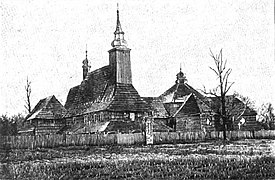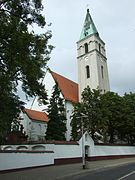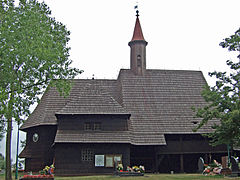Olesno
| Olesno | ||
|---|---|---|

|
|
|
| Basic data | ||
| State : | Poland | |
| Voivodeship : | Opole | |
| Powiat : | Olesno | |
| Gmina : | Olesno | |
| Area : | 15.10 km² | |
| Geographic location : | 50 ° 53 ′ N , 18 ° 25 ′ E | |
| Height : | 240 m npm | |
| Residents : | 9439 (December 31, 2016) | |
| Postal code : | 46-300 | |
| Telephone code : | (+48) 34 | |
| License plate : | OOL | |
| Economy and Transport | ||
| Street : | DK 11 Kołobrzeg - Bytom | |
| Rail route : | Lubliniec – Kluczbork | |
| Next international airport : | Katowice | |
Olesno (German Rosenberg OS ) is a small town with about 10,000 inhabitants in the Polish Opole Voivodeship . It is the seat of the Powiat Oleski and is the capital of the town-and-country municipality of the same name with around 17,800 inhabitants.
geography
The city is located in the northeastern part of Upper Silesia in the Woischnik-Wieluń highlands within the Lisswarther depression at 242 m above sea level. NHN , about 47 kilometers northeast of Opole (Opole) . The Stober (Polish: Stobrawa ), a right tributary of the Oder, flows west of the historic town center .
history

Olesno / Rosenberg is one of the oldest towns and settlements in Silesia . Archaeological excavations have revealed traces of Neolithic settlement in today's urban area. The strategic location on the edge of the Amber Road , which led from the Baltic Sea to the Mediterranean , and the Royal Route from Krakow to Breslau and on to Leipzig and Mainz, favored continuous settlement.
From the beginning the city belonged to the Duchy of Opole , which was subordinate to the Silesian Piasts . It was first mentioned in 1226 on the occasion of the consecration of St. Michael's Church by the Breslau bishop Laurentius . At the request of Opole Duke Casimir I , the bishop also notarized the “old” customs statute. From this it can be concluded that a border or customs settlement existed here before 1200. However, it is possible that this was in the northwestern village of Alt-Rosenberg . Presumably before 1267, Olesno was implemented under German law, as a "Vincentius castellanus de Olesno" is documented for this time. When the Duchy of Opole was divided after the death of Duke Wladislaus I , Rosenberg stayed with him. For the year 1292 the Weichbild Olesno ("District Olesno") is proven. The German place name "Rosenberg" appears for the first time in 1310, when Duke Boleslaus I sold the pedestrian duty in Rosenberg to the citizens of Wroclaw .
In 1327 the Opole duke Bolko II. Rosenberg transferred together with his duchy as a fiefdom to the crown of Bohemia , whereby it came under the sovereignty of Bohemia before the Treaty of Trenčín , whose sovereign was then Johann von Luxemburg . His son Charles IV incorporated Silesia into the crown of Bohemia as king in 1348 and as emperor in 1355, making it part of the Holy Roman Empire of the German nation . The existence of a city wall is recorded for the year 1395 . Heavy devastation took place in the Hussite Wars . In 1450, Duke Bernhard renewed the German town charter in Rosenberg. Agriculture, cattle breeding, hunting, fishing, handicrafts and trade were of economic importance. A document from the first half of the 15th century mentions malt houses , butchers , pottery and lime kilns .
The Habsburgs , ruling as kings of Bohemia since 1526 , to whom the Duchy of Opole fell after the death of the last Duke of Opole, Johann II. In 1532 , then pledged it several times. During the Thirty Years War , Silesia was largely devastated and lost a large part of its population.
After the First Silesian War , Rosenberg and most of Silesia fell to Prussia. Since the administrative reform in 1816, Rosenberg belonged to the administrative district of Opole and was the seat of the administrative district of Rosenberg , with which it remained connected until 1945.
The residents of Rosenberg suffered from numerous natural disasters, epidemics and wars. In the period from the 15th to the 18th century, the city burned down several times. However, it was rebuilt over and over again, and the population gradually increased. The plague of 1790 survived only about 90 inhabitants. Since the Reformation in Rosenberg had remained insignificant, it was not given its own Protestant community until 1847. By the second half of the 19th century, the city developed into an economic and cultural center in northern Upper Silesia. At the beginning of the 20th century, Rosenberg had a Protestant church, four Catholic churches, a synagogue , a Catholic school teacher seminar, a preparatory institute , a cement factory , a brick factory , two sawmills , a dairy and was the seat of a local court .
In the referendum in Upper Silesia in 1921, 3286 Rosenbergers voted to remain with the German Reich, 473 opted for Poland.
Until 1945 Rosenberg was the administrative seat of the district of Rosenberg OS in the administrative district of Opole in the Prussian province of Silesia of the German Empire .
Towards the end of the Second World War , the region was conquered by the Red Army in the spring of 1945 . After the end of the war, Rosenberg and large parts of Upper Silesia and Lower Silesia were placed under Polish administration by the Soviet Union . Then the immigration of Polish migrants began, some of whom came from areas east of the Curzon Line and belonged to the Polish minority there. Rosenberg was renamed Olesno . Most of the city's German residents were subsequently evicted by the local Polish administrative authorities .
From 1945 to 1975 the town and country of Olesno belonged to the Opole Voivodeship , then to the Częstochowa Voivodeship . After the administrative reform of 1999, Olesno was reintegrated into the Opole Voivodeship.
Demographics
| year | population | Remarks |
|---|---|---|
| 1816 | 1480 | |
| 1825 | 2074 | including 244 Evangelicals and 306 Jews |
| 1840 | 2703 | including 324 Evangelicals, 2093 Catholics, 285 Jews, one Greek Orthodox |
| 1871 | 3342 | with the garrison (a battalion Landwehr No. 63), including 350 Evangelicals and 350 Jews (2000 Poles ) |
| 1890 | 3740 | 540 Evangelicals, 2984 Catholics, 216 Jews (2100 Poles ) |
| 1905 | 5222 | 658 Protestants, 142 Jews |
| 1925 | 5877 | |
| 1933 | 6944 | |
| 1939 | 7280 |
politics
Town twinning
coat of arms
The city's coat of arms is split. In the front field it shows half a golden eagle on a blue background. In the back field it shows half a red rose on a silver background.
local community
The urban-and-rural municipality of Olesno has about 17,800 inhabitants and an area of 240.8 km², of which 42% is covered with forest.
Attractions
- neoclassical town hall from 1820/21, Nepomuk statue and museum on the ring.
- Roman Catholic Corpus Christi Church - 1910-1913 designed by Oscar Hossfeld built
- Cemetery chapel
- Roman Catholic Michaelikirche
- Evangelical Kreuzkirche
- Annakirche , a pilgrimage church made of scrap wood from the 16th century.
- Rochuskirche , a pilgrimage church made of scrap wood from the 18th century.
- Jewish Cemetery
- Hospital chapel
traffic
The state road Droga krajowa 11 runs through the village . Other regional highways are Droga wojewódzka 487 , Droga wojewódzka 494 and Droga wojewódzka 901 .
The Olesno Śląskie station is on the Lubliniec – Kluczbork railway , with further stops in Sowczyce and Stare Olesno, and there used to be a connection to the Rosenberg circular railway .
Personalities
sons and daughters of the town
- Georg Adam Franz von Gashin (1643–1719), governor of the principalities of Ratibor and Opole
- Carl Ludwig von Ballestrem (1755–1829), major councilor and mining industrialist
- Hermann Friedberg (1817–1884), forensic doctor
- David Rosin (1823-1894), Jewish theologian
- Albert Kinel (1825–1911), architect and railroad builder
- Wilhelm von Dresow (1829–1895), Prussian general of the infantry
- Karl von Wallhofen (1831-1894), member of the Reichstag (center)
- Valeska Countess Bethusy-Huc (1849–1926), writer
- Adolf Weißmann (1873–1929), music critic
- Franziska Steinitz (1875–1942), Romance writer and translator
- Reinhold Saltzwedel (1889–1917), naval officer and submarine captain
- Oswald Lehnich (1895–1961), politician (NSDAP)
- Gerhard Orzechowski (1902–1977), physician
- Egon Kubuschok (1902–1981), lawyer
- Lothar Klingberg (1926–1999), teacher and didactic specialist
- Rudolf Bartsch (1929–1981), writer
- Franciszek Kokot (* 1929), doctor, nephrologist and endocrinologist
- Gerard Rogowski (* 1931), Roman Catholic clergyman
- Engelbert Kupka (* 1939), politician (CSU)
- Andrzej Czaja (* 1963), Bishop of Opole
- Justine Seewald (* 1972), radio play speaker
- Adam Ledwoń (1974–2008), Polish-German football player
- Anna Wloka (* 1993), Polish shot putter
- Vera Scholz von Reitzenstein (1924–2018), sculptor and sculptor
Personalities who have worked on site
- Christian Hölmann (1677–1744), physician and poet, plague doctor in Rosenberg
- Daniel Latussek (1787–1857), auxiliary bishop and capitular vicar, temporarily chaplain in Rosenberg
- Jakob Levy (1819–1892), rabbi and linguist, 1845–1850 rabbi in Rosenberg
- Franz Welczek (1825–1901), royal chancellery and city councilor in Kreuzburg, spent part of his childhood in Rosenberg
- Oskar Hossfeld (1848–1915), architect, designed the plans for the construction of the Corpus Christi parish church
- Bruno Seibt (1856–1933), politician, 1884–1888 magistrate in Rosenberg
- Bruno Goebel (1860–1944), organ builder, temporarily trained in Rosenberg
- Rudolf Pastucha (* 1936), Lutheran theologian and former bishop, temporarily pastor in Olesno
Honorary citizen
- Prof. Franciszek Kokot
- Bernhard Jagoda (1940–2015), politician (CDU) and President of the Federal Employment Agency in Nuremberg
- Gerhard kiss
- Wolfgang Weidel
- Ilkka Liukas-Fin.
literature
- Karl August Müller: Patriotic images, or history and description of all castles and knight palaces in Silesia and the county of Glatz. Second edition, Glogau 1844, pp. 149–151.
- Johann Georg Knie : Alphabetical-statistical-topographical overview of the villages, towns, cities and other places of the royal family. Preusz. Province of Silesia. 2nd Edition. Graß, Barth and Comp., Breslau 1845, p. 910 .
- Hugo Weczerka (Hrsg.): Handbook of the historical places . Volume: Silesia (= Kröner's pocket edition . Volume 316). Kröner, Stuttgart 1977, ISBN 3-520-31601-3 , pp. 443-447.
- Dehio Handbook of Art Monuments in Poland. Silesia. Deutscher Kunstverlag, Munich et al. 2005, ISBN 3-422-03109-X , pp. 683–685
- Silesia. DuMont KunstReisführer, Ostfildern 2006, ISBN 978-3-7701-4418-1 , p. 192.
Web links
- Website of the city and municipality of Olesno (Polish)
- Christian Weidel: Welcome to Rosenberg O / S - Witamy w Olesnie Śląskim (German, Polish)
- Olesno City Library ( Oleska Biblioteka Publiczna ) (Polish)
- City map of Olesno (mapa.szukacz.pl)
Individual evidence
- ↑ a b Meyer's Large Conversation Lexicon . 6th edition, Volume 17, Leipzig / Vienna 1909, p. 148 .
- ↑ Archived copy ( memento of the original from September 24, 2015 in the Internet Archive ) Info: The archive link was inserted automatically and has not yet been checked. Please check the original and archive link according to the instructions and then remove this notice.
- ^ A b Gustav Neumann : The German Empire in geographical, statistical and topographical relation . Volume 2, GFO Müller, Berlin 1874, p. 173 .
- ↑ Johann Georg Knie : Alphabetical-statistical-topographical overview of the villages, spots, cities and other places of the royal family. Prussia. Province of Silesia, including the Margraviate of Upper Lusatia, which now belongs entirely to the province, and the County of Glatz; together with the attached evidence of the division of the country into the various branches of civil administration. Melcher, Breslau 1830, pp. 1007-1008 .
- ^ Johann Georg Knie : Alphabetical-statistical-topographical overview of the villages, spots, cities and other places of the royal family. Preusz. Province of Silesia. 2nd Edition. Graß, Barth and Comp., Breslau 1845, p. 910 .
- ↑ a b c d M. Rademacher: German administrative history from the unification of the empire in 1871 to the reunification in 1990. (Online material for the dissertation, Osnabrück 2006)








